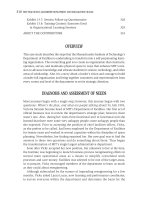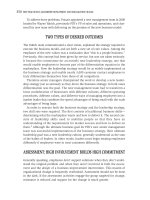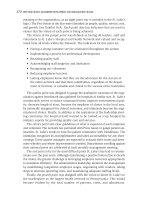Tài liệu Best Practives in Leadership Development & Organization Change 47 doc
Bạn đang xem bản rút gọn của tài liệu. Xem và tải ngay bản đầy đủ của tài liệu tại đây (156.66 KB, 10 trang )
employees, and physicians. The physicians were the most difficult and most
important change agents. At times they acted as desperate victims as the core
of their power was diminished.
Employees
Another key to the process was the employee. Change at the staff level was crit-
ical. Employees were rewarded for being caught caring. They were empowered
to make things right when patients or their family members were upset. They
were encouraged to go the extra mile when necessary. For the first two years
this worked beautifully.
As the bottom fell out of health care due to the shortage of registered nurses
and the impact of the Balanced Budget Amendment, however, those employees
who were motivated not to change began using the Planetree philosophy as a
lever to get even with administration.
Any time the employees, specifically nurses and laboratory technologists,
were upset about pay raises or working conditions, they were less attentive to
the patients, and told the patients and their families that they were overworked
and underpaid. Both of these statements were true.
The manner in which management corrected this problem involved sur-
rounding the patients with volunteers and complementary care givers. A typi-
cal patient would be seen by a massage therapist, aroma therapist, behavioral
psychologist, clergy, volunteers with art carts, and, when desired, pets for pet
therapy.
FEEDBACK USE
Planetree teams were put together to teach, train, and gather feedback from the
employees. After the first two years of change, meaningful growth, and strong
profits, during which time the employees enjoyed significant increases in salary,
morale was at an all time high.
During the following two years the finances were the driving force behind
the primary unrest. These Planetree teams served an integral part of the cura-
tive process for advancing the philosophy.
Each meeting started with a venting session intended to allow the employ-
ees in attendance the opportunity to express themselves. After each session the
team would prepare anonymous debriefing reports to be read by senior leader-
ship. This feedback began to bring light to the subject of the employee’s
concerns.
The Planetree team made sure that all participants had access to the sum-
mary pages as well. The president discussed the findings with employees during
his regular employee meetings. Due to these findings, employee satisfaction
430
BEST PRACTICES IN LEADERSHIP DEVELOPMENT AND ORGANIZATION CHANGE
cart_14399_ch18.qxd 10/19/04 1:20 PM Page 430
surveys, Lunch with the President, individual meetings, and newsletters were
all forthcoming.
In spite of all of these ongoing efforts, nothing changed until a windfall came
to the hospital through a settlement with an insurance provider that enabled
the hospital to give 30 percent raises to key caregivers. The reality here is that
happy, well-paid employees were critical to the success of Planetree.
DESIGN: PLANETREE PHILOSOPHY
The core of the Planetree philosophy is as old as human healing and caring. It
involves the holistic care that nurtures the mind, body, and spirit. It embraces
the creation of an environment that recognizes a healing process that does not
emanate purely from drugs or surgeries. It is a truth that has been known for
thousands of years but has been overpowered during the past fifty years by
modern medicines.
Planetree embraces a philosophy that includes the creation of a healing envi-
ronment through architecture, natural light, plants, music, aroma therapy, the
presence and encouragement of loved ones, and the nurturing provided by
clergy and psychologists.
Each day bread is baked in the hallways, popcorn is popped in the lobby,
music is played, and massage is offered to patients as they wait, to the employees
at their workstations, and to the physicians in the hallways and in their offices.
More important, the patients are empowered to ask, participate, and know.
It is all about the belief that healing can occur in many ways.
INTERVENTION: FUNDAMENTAL CHANGES
The work of the Planetree teams, the senior leadership, the board and staff was
all-inclusive and continues to this day. Each aspect of this change culture
was carefully planned, executed, and managed.
• Formal on-the-job training and classroom training from internal Plane-
tree leaders, consultants from Planetree staff, and outside consultants
• Annual refresher course for all employees
• Employee training course for all new hires
• Establishment of an anonymous telephone hotline for employees to
identify any feelings of wrong doing toward them
• Celebration of major accomplishments with parties, ice cream sundaes,
dinner certificates, awards, trips to baseball games, and cash; recognition
in written communication and gifts from senior managers
WINDBER MEDICAL CENTER
431
cart_14399_ch18.qxd 10/19/04 1:20 PM Page 431
• Empowerment of employees with the authority to care for patients’
needs up to $300 in costs per incident
• A portion of the employee compensation is tied to performance
Success Factors
1. The extensive training by professionals and peers
2. Mention of Planetree in every communication to employees made it
the single focus of the mission of the organization
3. Employee recognition by senior leadership
4. The president’s walk the talk approach
5. The humanistic approach to the removal of employees who would
never be able to provide Planetree care
6. Recognition by local, regional, and national press for the unique
patient-centered care, trademarked Windbercare, provided by the
employees and volunteers at Windber Medical Center
Together, these factors helped overcome the internal resistance and program
obstacles.
THE PLANETREE TEAMS
The value of the Planetree teams cannot be discounted. It was because of their
ongoing work and dedication that progress occurred. These employees worked
dozens of hours on their own time at special meetings on and off campus to
ensure that the Planetree sessions were meaningful.
Because the sessions were peer to peer, they were much more effective.
All employees were required to attend sessions where sensitivity training
occurred. Role-playing of employees as patients was an important part of the
programs.
A SWAT team made up of social workers, psychologists, and clergy provides
on-the-job help. This crisis intervention team was an important aspect of
providing support for employees when crisis situations arise.
LOOKING BACK
The transition of a small, 102-bed, urban hospital located in a community of
less than four thousand people to national prominence was neither easy nor
safe. The president of the organization was challenged numerous times by
432
BEST PRACTICES IN LEADERSHIP DEVELOPMENT AND ORGANIZATION CHANGE
cart_14399_ch18.qxd 10/19/04 1:20 PM Page 432
physicians, system executives, and employees. It was a passion for change that
allowed the dream to become a reality. None of the goals could have been
accomplished without hard work and commitment from the entire staff.
The Change Circle
The textbooks talk about unfreezing, changing, and refreezing a culture. In this
case the refreezing of the culture is a never-ending task. The change circle for
moving a traditional hospital to the Planetree model takes years. As the reputa-
tion of the organization continued to grow, new physicians and employees
attracted to the holistic, caring culture came seeking employment at the facil-
ity. The addition of these special caregivers enabled the culture to change more
dramatically and completely. It also began to balance the power of the medical
staff.
The organization was a typical Industrial Revolution model. Employees
clocked in each day minutes before they were to be at their position within the
hospital. They went to their workstations, and the day revolved around
the physicians’ and employees’ schedules.
In many cases, the staff did not recognize the patient as a customer. The
patient was an inconvenience. Their presence was an interruption.
In order to see the need for change, studies depicting the future demise of
the organization were made available at employee meetings. These studies were
not used as gospel but only as a warning signal that the organization had five
years to make a significant change.
The importance of making the patient the center of care was a difficult job.
It was totally foreign to the culture of much of health care. Although the
employees of Windber Medical Center and especially those of the palliative care
unit were exceptionally caring individuals, the general rule of thumb was that
the rules were the rules. Patients were scheduled at the convenience of the
physician and the technician. This required the changes previously outlined.
It Gets Worse Before It Gets Better
The overall atmosphere of the organization was one of waiting for the wave to
pass over. In fact, each aspect of the Planetree philosophy was undermined,
ignored, and blatantly pushed aside while the employees waited for their fifth
president to be fired or their sixth manager to be promoted or dismissed. It was
the revolving door theory. If you ignore it, they will go away. When it became
obvious that the change agents and the philosophy were, for the most part,
going to stay, then positive reinforcement could begin to take hold.
It was also a we-they relationship with the physicians and employees. One
physician had all of the nurses on his group e-mail and used that e-mail to
undermine the senior leaders on a regular basis. So those employees would cling
to their protective physician for power as they ignored management.
WINDBER MEDICAL CENTER
433
cart_14399_ch18.qxd 10/19/04 1:20 PM Page 433
I’m from the Government and I’m Here to Help
As the program moved forward and received the positive attention of local
politicians, federal, state, and local grants began to pour into the organization
for special programs, research projects, and capital additions.
Instead of pleasing the employees, making them happy and secure, these
grants caused jealously between the departments that received them and
those that did not. As new buildings came on line, the employees located in
the older buildings were resentful and openly hostile. As new employees came
on board, the long-time employees were disruptive and, many times, unkind
toward them.
It was a very interesting evolution that did not and could not work out until
salaries, remodeling, and attention occurred housewide, five years into the
transition.
Getting Back on Track
After several years of training, growth through increased census and patient
numbers, grants, and national recognition, Planetree began to take hold as a
way of life at Windber Medical Center. There are still physicians who do not
want to allow patient empowerment, there are still not always care teams in
place, there are days when patients don’t smell the bread, see the volunteers,
or see the special complementary medicine specialists, but 95 percent of the
time, things are as they should be.
Because we wanted everyone to feel as though they were in the best five star
hotel, a spa, and a healing garden, we hired a hotel manager to run our house-
keeping, dietary, and maintenance departments and provide room service, fresh
flowers, bread, live music, artwork, and fountains and invite loved ones to stay
with their sick relatives. We have unlimited visiting hours. We also provide
pajama bottoms and bathrobes. More like their home or better. A healing
environment.
In our birthing suites, we have midwives in room deliveries and use such
complementary therapies as birthing balls, aromatherapy, music and massage
therapy, infant massage, Jacuzzi tubs, and hand-held massagers. We also have
double beds for the families to use after the baby is born. Mother, father, and
baby occupy the same room. These birthing suites also contain computer
hookups to the Internet, live music, and TV-VCR, and we bake fresh bread daily
and offer tea and coffee.
As part of our commitment to the community, we have added a “Center for
Life.” This is the senior center for senior citizens. Seniors come each day and
have access to our gym, our doctors, and trained staff. In this center, older
citizens have access to social services and preventative health options.
434
BEST PRACTICES IN LEADERSHIP DEVELOPMENT AND ORGANIZATION CHANGE
cart_14399_ch18.qxd 10/19/04 1:20 PM Page 434









